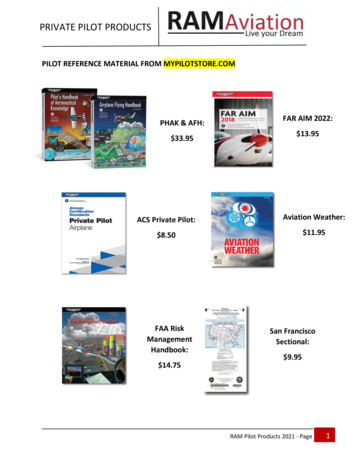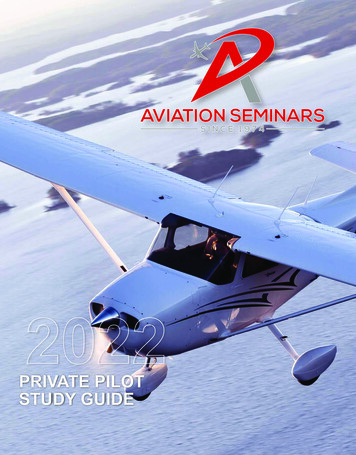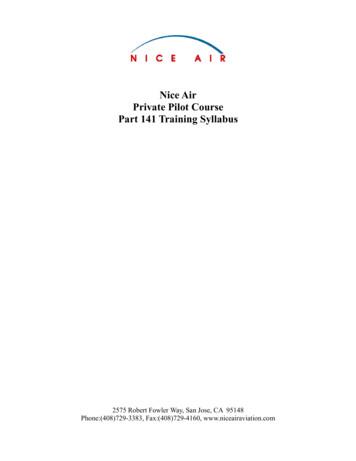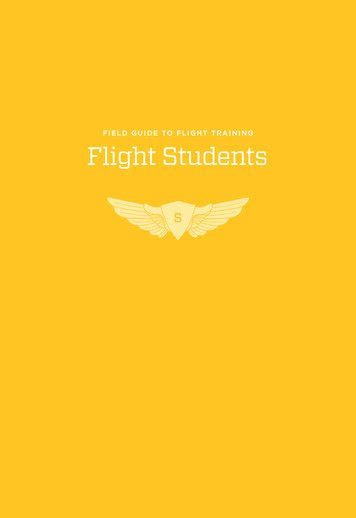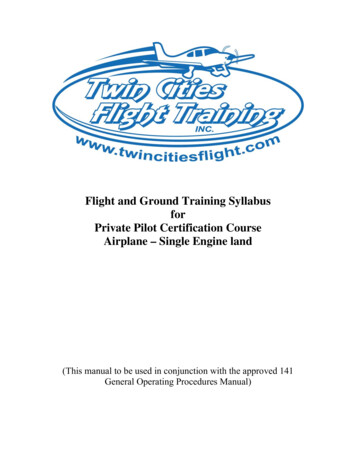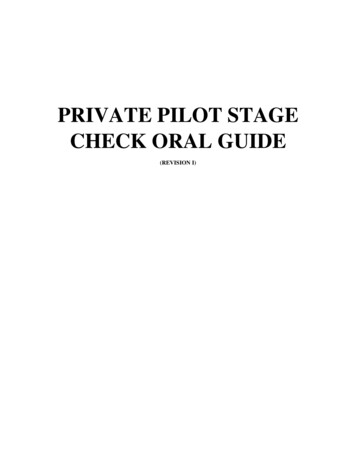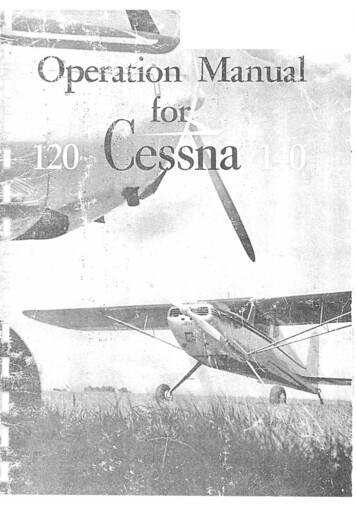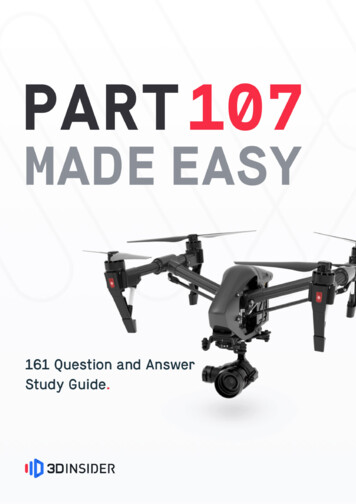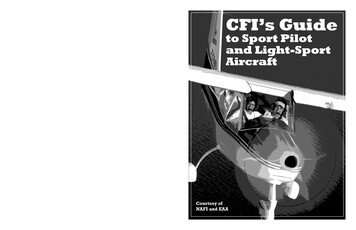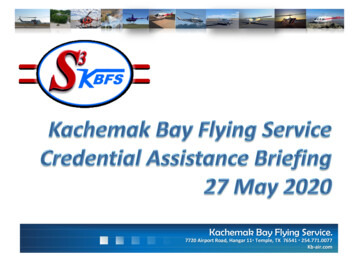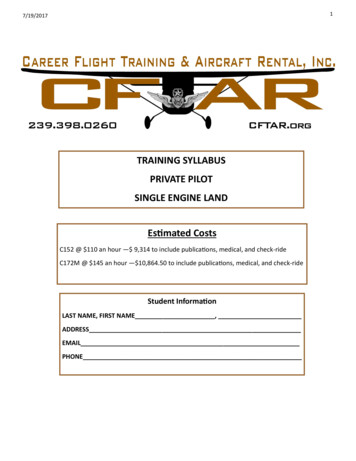
Transcription
17/19/2017TRAINING SYLLABUSPRIVATE PILOTSINGLE ENGINE LANDEstimated CostsC152 @ 110 an hour — 9,314 to include publications, medical, and check-rideC172M @ 145 an hour — 10,864.50 to include publications, medical, and check-rideStudent InformationLAST NAME, FIRST NAME ,ADDRESSEMAILPHONE
2Page 3 . IntroductionPage 4 . Recommended ResourcesPage 5 . Flight Lesson 1 (Dual) — Intro FlightPage 6 . Flight Lesson 2 (Dual) — Climb/Descents & Straight and LevelPage 7 . Ground Lesson 1 — Aerodynamics/WX/PerformancePage 8 . Flight Lesson 3 (Dual) — ManeuversPage 9 . Flight Lesson 4 (Dual) — ManeuversPage 10 . Flight Lesson 5 (Dual) — Ground Effect (KTNT)Page 11 . Flight Lesson 6 (Dual) — Soft/Short Field WorkPage 12 . Flight Lesson 7 (Dual) — Soft/Short Field WorkPage 13 . Flight Lesson 8 (Dual) — Student Centered LandingsPage 14 . Flight Lesson 9 (Dual) — Student Centered Pre-SoloPage 15 . Flight Lesson 10 (Dual) — ManeuversPage 16 . Flight Lesson 11 (Dual) — Towered Airport OperationsPage 17 . Flight Lesson 12 (Dual) — Emergency ProceduresPage 18 . Pre-Solo Stage CheckPage 19 . Flight Lesson 13 (Dual/Solo) — Student Solo PreparationPage 21 . Flight Lesson 14 (Dual) — Post Solo Local Area NavigationPage 22 . Flight Lesson 15 (Solo) — Maneuvers/Navigation/SAPage 24 . Flight Lesson 16 (Dual) — SIM INST X 0.5 HoursPage 25 . Flight Lesson 17 (Dual) — SIM INST X 1.0 HoursPage 26 . Flight Lesson 18 (Solo) — Maneuvers/Touch and GoesPage 27 . Flight Lesson 19 (Solo) — Maneuvers/Touch and GoesPage 28 . Ground Lesson 2 — Cross-Country PlanningPage 29 . Flight Lesson 20 (Dual) — Cross-Country w/ SIM INST X 0.5Page 30 . Flight Lesson 21 (Dual) — Night Flight w/ SIM INST X 0.5Page 31 . Flight Lesson 22 (Dual) — Night Cross-CountryPage 32 . Flight Lesson 23 (Dual) — Class D OperationsPage 33 . Flight Lesson 24 (Solo) — Class D OperationsPage 34 . Flight Lesson 25 (Dual) — Class C OperationsPage 35 . Flight Lesson 26 (Solo) — 150 Nautical Mile Cross CountryPage 36 . Flight Lesson 27 (Dual) — Mock Check Ride
3INTRODUCTIONThis training syllabus is designed to optimize the training effort between the instructor(s) and student.The plan is for one to obtain her/his rating in under 50-hours of training. Of course this is determined by thefidelity for which one puts into the training time. The goal is for each area to be fully understood by the trainee, and for her/him to seek additional help from the recommended resources or outside sources. The instructor’s role is to facilitate the training process and ensure that the trainee is able to operate within her/his prescribed limitations. Safety is paramount in all operations. It is important for the trainee to know and understand her/his limitations.Enclosed is a recommended resources list. This includes equipment and knowledge based resources.The optional marked items can ease in the understanding of the material; however, the Pilots Handbook ofAeronautical Knowledge (PHOAK), the Airplane Flying Handbook (AFH), and the Airmen Certification Standards(ACS) covers the knowledge that one is required to learn for their rating. The other items may go further indepth than the required pubs. It is recommended that the student have a flight bag for her/his charts and publications needed in flight and flight gear, and the trainee have a book bag for the other books for which she/heshould bring to every training session.The syllabus is designed with post reading recommendations to either solidify knowledge or introducethem to the next training session. The instructor or student may alter the sequence of training modules to tailor to the student’s needs.This outline will maximize the efficiency of the training process. The goal is for the student to take fullownership of the training process and wean herself/himself from the instructor as soon as safely possible. Thestudent should have the aircraft prepared and all preflight data accomplished as soon as the instructor authorizes them to do so. This will save money with ground training charges.This syllabus is an estimate. With the estimates the student will pay a total of 3564 in instructorcharges for ground in flight. This is an estimate of 26.1 ground hours and 33.3 dual instruction hours in the aircraft. The cost for the aircraft will either be 4430.00 (CH2000 @ 100 an hour) or 5980.50 (C172M @ 135per hour). This leaves a total cost of 7994.00 for the CH2000 and 9544.50 for the C172M. Also, the clientmay split the difference between the two aircraft. One would have to have a body weight of under 170 poundsto train in the CH2000. These costs do not include approximately 600 needed for equipment and publications, 120 for the third class medical, and the 600 for the actual check-ride.It is recommended to fly at least 3 times a week to ensure consistency with instruction. It is estimatedthat for each 7-days that you go without flying then you are set back 2 to 3 hours in your overall training plan.Of course this varies depending on when you take the break. For example, if you finish the solo phase andthen take a break before your cross-country training, then the training may be consolidated when you resume.Enjoy your endeavor to earning your privilege to fly the skies. Make the best of each training sessionand assist CFTAR with your learning environment. Remember that you are the customer and in charge of instructor and flight school selection. At no time are you indebted to CFTAR for your training needs. Any trainingcompleted with CFTAR will transfer to another school of your choosing. Lastly, flight training is a life changingevent that you must totally immerse yourself in for the maximum product of safety and completion.
4RECOMMENDED RESOURCES Head-set — prices range from 100 to 1,200 for headsets. Comfort, sound and accessories are the maincost considerations. Pilot’s Handbook of Aeronautical Knowledge (2016) — Internet (FAA.GOV) and/or Hard Copy — https://www.faa.gov/regulations policies/handbooks manuals/aviation/phak/ Airplane Flying Handbook (2016) — Internet/and or Hard Copy — https://www.faa.gov/regulations policies/handbooks manuals/aviation/airplane handbook/ (Optional) Jeppesen Guided Flight Discovery Private Pilot 2010 (Optional) Rod Machado’s Private Pilot Handbook Gleim Private PIlot FAA Knowledge Test Prep Book Gleim Private Pilot FAA Knowledge Test Prep Internet Software Interaction Course E6B computer Plotter Foggles Kneeboard Logbook Private Pilot Airplane Airman Certification Standards — Internet or Hard Copy (recommended) — https://www.faa.gov/training testing/testing/acs/media/private airplane acs.pdf Private Pilot Oral Exam Guide — Hard Copy. Miami Sectional Airport Facility Directory FAR/AIM — Current Year Hard Copy Airplane Operating Handbook (Applicable Aircraft) AOPA.org
5FLIGHT LESSON 1 (Dual)GROUND x 0.5 HOURS Discuss citizenship requirements and documents needed (Birth Certificate or VISA) and photo ID Discuss medical disqualifications and criminal record consequences Discuss costs and frequency of invoicing/payment Discuss Chapter 3 Airplane Flying Handbook “Attitude Flying” (Figures 3-6 through 3-8) Discuss Towered and Non Towered Airport differences Discuss Controls and Axis of Flight for each Discuss Bernoulli’s Principle and Newton’s 3rd Law Introduce AOPA.ORG Know Before You Go Course — how to accessFLIGHT x 0.5 TO 0.8 HOURS Safety Briefing Taxi Operations — Instructor Demonstrate and Pilot Perform Take-off Vx versus Vy demonstration Straight and level flight using Chapter 3 “attitude” principles Climbs using Chapter 3 “attitude” principles Descents using Chapter 3 “attitude” principles Trim overview and usage. Turns while straight and level Turns while climbing and descendingPOST FLIGHT Post flight Logbook SchedulingInstructor Notes:Post Reading Recommendations:Airplane Flying Handbook Chapters 1 through 3.Gliem Study Unit 1 (Airplanes and Aerodynamics)ESTACTESTACT0.0Ground time CF /0.0Flight time CF /0.5Ground today /0.8Flight Today /0.5Ground Total /0.8Flight Total /Instructor SignatureStudent SignatureAOPA.ORG — Complete Essential AerodynamicsCoursePilots Handbook of Aeronautical KnowledgeChapter 2 (Aircraft Structure)
6FLIGHT LESSON 2 (Dual)GROUND x 1.0 Discuss Chapter 3 from Airplane Flying Handbook Discuss Gleim Study Unit One Discuss I, Task A of ACS — Pilot Qualifications Discuss I, Task B. of ACS — Airworthiness Requirements Discuss I, Task G of ACS — Operation of Systems Discuss POH and Checklist Discuss Vy and Vx speeds Flight Instructor demonstrates Preflight and Discusses Gleim Study Unit 1 Principles Flight Instructor verifies citizenship and makes copies of required documents (Birth Certificate/VISA and Photo ID)FLIGHT x 1.0 TO 1.5 Flight Instructor demonstrates checklist usage, start-up, taxi, and run-up techniques Climbs using Vy and Vx 10/-5 knots per aircraft POH Turns /- 10-degrees Level off /- 100 feet Trim Descents With and Without Flaps /- 100feet Integrated Flight Instruction Clearing Procedures Heading and Altitude Control /- 10-degrees and /- 100 feet Flight Instructor Discusses and Demonstrates Traffic Pattern Entry and Positions Post FlightInstructor Notes:Post Reading Recommendations:ESTACTESTACT0.5Ground time CF /0.8Flight time CF /1.0Ground today /1.5Flight Today /1.5Ground Total /2.3Flight Total /Instructor SignatureStudent SignatureAirplane Flying Handbook Chapter 7 (TrafficPatterns)PHOAK Weather Theory and Aviation WeatherServices (Overview Only)Practice Test Session Study Unit 1 Gleim until 90%accuracy rateRead Gleim Study Unit 2 Airplane Instruments,Engines, and SystemsAOPA.ORG — Complete Engine and Propeller andPneumatic Systems
7GROUND LESSON 1 X 1.0 HOURS Discuss Pitch, Roll, and Yaw in combination with the Axes Discuss Load Factor Discuss Critical Angle of Attack Introduce ACS I, Task C (Weather Information) Demonstrate how to Obtain METAR”s Demonstrate Crosswind Component Demonstrate how to determine if Airport is VFR Discuss diversions Discuss Thunderstorms Review Traffic Pattern Procedures Apply for student pilot certificate in IACRA Give information to obtain medicalInstructor Notes:ESTACTESTACT1.5Ground time CF /2.3Flight time CF /1.5Ground today /0.0Flight Today /3.0Ground Total /2.3Flight Total /Instructor SignatureStudent SignaturePost Reading Recommendations:Review Chapter 2 in Airplane Flying HandbookRead Chapter 4 Airplane Flying Hanbook Stop on page 4-17 at Upset Prevention andRecoveryRead Chapter 6 Airplane Flying Handbook Introduction Rectangle Course/Pattern Turns Around a Point S-TurnsRead Chapter 9 Airplane Flying Handbook Steep TurnsStudy Practice Questions in Gleim Study Unit 2Airplane Instruments, Engines, and Systems
8FLIGHT LESSON 3 (Dual)GROUND x 0.5 Student prepares Preflight for weather and makes a go/nogo decision Student conducts preflight of aircraftFLIGHT X 1.5 Student performs start-up and run-up procedures Depart to training area focusing on Collision Avoidance, Integrated Flight Instruction, and Pilotage/Situational Awareness Flight Instructor demonstrates Steep Turns Flight Instructor Demonstrates Slow Flight and Stalls (PWR-ON and OFF) with Recovery Techniques Flight Instructor Demonstrates Ground Reference Maneuvers Rectangle Course/Pattern S-Turns Turns Around a Point Post Flight Check status on medicalInstructor Notes:ESTACTESTACT3.0Ground time CF /2.3Flight time CF /0.5Ground today /1.5Flight Today /3.5Ground Total /3.8Flight Total /Instructor SignatureStudent SignaturePost Reading Recommendations:Review Chapter 2 in Airplane Flying HandbookReview Chapter 4 Airplane Flying Hanbook Stop on page 4-17 at Upset Prevention andRecoveryReview Chapter 6 Airplane Flying Handbook Introduction Rectangle Course/Pattern Turns Around a Point S-TurnsReview Chapter 9 Airplane Flying Handbook Steep TurnsConduct Practice Test in Gleim Study Unit 2 until90% accuracy rate
9FLIGHT LESSON 4 (Dual)GROUND x 2.0 Student prepares Preflight for weather and makes a go/nogo decision Student conducts Aircraft Preflight Discuss ACS V. Tasks A and B Discuss Checklist and start-up and run-up procedures FLIGHT X 1.5 Depart to training area focusing on Collision Avoidance, Integrated Flight Instruction, and Pilotage/Situational Awareness Student Practices Steep Turns Student Practices Slow Flight and Power-ON and OFF stalls Student Practices Ground Reference Maneuvers Rectangle Course/Pattern S-Turns Turns Around a Point Post FlightInstructor Notes:ESTACTESTACT3.5Ground time CF /3.8Flight time CF /2.0Ground today /1.5Flight Today /5.5Ground Total /5.3Flight Total /Instructor SignatureStudent SignaturePost Reading Recommendations:Read Chapter 8 in Airplane Flying Handbook(Approaches and Landings)Review Chapter 4 Airplane Flying Hanbook Stop on page 4-17 at Upset Prevention andRecoveryReview Chapter 6 Airplane Flying Handbook Introduction Rectangle Course/Pattern Turns Around a Point S-TurnsReview Chapter 9 Airplane Flying Handbook Steep Turns
10FLIGHT LESSON 5 (Dual)GROUND x 0.5 Student prepares Preflight for weather and makes a go/nogo decision Student conducts aircraft preflight Discuss ACS III. Task B Discuss ACS IV. Tasks A and B Discuss Ground Effect Fuel Consumption and Title 14 FAR 91.151 Introduce Airport Data through Airport/Facility DirectoryFLIGHT X 1.5 Depart to KTNT focusing on Collision Avoidance, Integrated Flight Instruction, and Pilotage/Situational Awareness Conduct Pilotage to KTNT Student enters appropriate frequencies for AWOS/ASOS and CTAF Flight Instructor demonstrates Dragging the Runway with full flaps and at MCA while maintaining ground effect Traffic Pattern altitude is /- 100 feet and airspeed /- 10 Knots Conduct Pilotage to KMKY Post FlightInstructor Notes:ESTACTESTACT5.5Ground time CF /5.3Flight time CF /0.5Ground today /1.5Flight Today /6.0Ground Total /6.8Flight Total /Instructor SignatureStudent SignaturePost Reading Recommendations:Review Chapter 8 in Airplane Flying Handbook(Approaches and Landings)Chapter 14 in PHOAKAOPA.ORG — Complete the Runway SafetyCourseStart on Pre-Solo Exams
11FLIGHT LESSON 6 (Dual)GROUND x 0.5 Student prepares Preflight for weather and makes a go/nogo decision Student conducts aircraft preflight Discuss Chapter 14 in PHOAK Discuss traffic pattern procedures Discuss Soft Field Take-offs Discuss Short Field Take-offs Discuss Go-Around proceduresFrom this lesson forward student will have the following accomplished prior to the arrival of the instructor.1. Aircraft preflighted2. METARS/WX BriefingFLIGHT X 1.0 Conduct 9 touch and go landings in the KMKY traffic pattern per ACS III (Task B) and IV (A, B, C, E, G, and N) Flight Instructor demonstrates Soft Field Take-off Flight Instructor demonstrates Short Field Take-off Flight Instructor demonstrates Confined Area Take-off Student attempts to conduct normal landings Post FlightInstructor Notes:ESTACTESTACT6.0Ground time CF /6.8Flight time CF /0.5Ground today /1.0Flight Today /6.5Ground Total /7.8Flight Total /Instructor SignatureStudent SignaturePost Reading Recommendations:Gleim Study Unit 3 (Airports, Air Traffic Control,and AirspaceAOPA.ORG — Complete the Know Before You GoCoursePHOAK — Read Chapter 15 (Airspace)
12FLIGHT LESSON 7 (Dual)GROUND x 0.5 Discuss and provide an overview on AirspaceFLIGHT X 1.0 Conduct 9 touch and go landings in the KMKY traffic pattern per ACS III (Task B) and IV (A, B, C, E, G, and N) Student demonstrates Soft Field Take-off Student demonstrates Short Field Take-off Student demonstrates Confined Area Take-off Student attempts to conduct normal landings Post FlightInstructor Notes:ESTACTESTACT6.5Ground time CF /7.8Flight time CF /0.5Ground today /1.0Flight Today /7.0Ground Total /8.8Flight Total /Instructor SignatureStudent SignaturePost Reading Recommendations:Gleim Study Unit 3 (Airports, Air Traffic Control,and Airspace — Practice test until 90% accuracyAOPA.ORG — Complete Say the Right thingCoursePHOAK — Read Chapter 10 Weight and Balance
13FLIGHT LESSON 8 (Dual)GROUND x 0.5 Discuss Airspace Discuss Radio Calls in the Pattern for non towered airport Introduce Weight and BalanceFLIGHT X 1.0 Conduct 9 touch and go landings in the KMKY traffic pattern per ACS III (Task B) and IV (A, B, C, E, G, and N) Student demonstrates normal take offs and landings Student practices radio calls in pattern at non-towered airport. Post FlightInstructor Notes:ESTACTESTACT7.0Ground time CF /8.8Flight time CF /0.5Ground today /1.0Flight Today /7.5Ground Total /9.8Flight Total /Instructor SignatureStudent SignaturePost Reading Recommendations:PHOAK — Read and study Class D airspaceAirport/Facility Directory — Review Naples Municipal AirportSectional Chart (Miami) — Review the differencesbetween Marco Island Executive Airport and Naples Municipal AirportGleim Study Unit 3 (Airports, Air Traffic Control,and Airspace — Practice test until 90% accuracy
14FLIGHT LESSON 9 (Dual)GROUND x 0.5 Student Works Weight and Balance prior to flight Review Weight and Balance Discuss Naples Municipal Airspace and requirements Discuss and practice towered radio calls Discuss Transponder operations and the difference between Classes D, C, and B airspaces Introduce Airport Diagram and its use Review runway markings Discuss Study Unit 3 in the Gleim PPL Knowledge Test Prep Discuss Frequencies, Ground and TowerFLIGHT X 1.5 Depart KMKY for KAPF Flight Instructor demonstrates obtaining ATIS and initial radio calls Student practices radio calls in pattern with instructor assistance Conduct 5 touch and go landings in the KMKY traffic pattern per ACS III (Task B) and IV (A, B, C, E, G, and N) Instructor demonstrates unusual attitude recoveries Student conducts unusual attitude recoveries Student demonstrates normal take offs and landings Post FlightInstructor Notes:Post Reading Recommendations:PHOAK — Review Runway markingsAFH — Chapter 4 (Maintaining Aircraft Control)ESTACTESTACT7.5Ground time CF /9.8Flight time CF /0.5Ground today /1.5Flight Today /8.0Ground Total /11.3Flight Total /AFH — Chapter 8 (Approaches and Landings)Review appropriate aircraft POH for rejectedlandings proceduresRehearse/chair fly rejected landings or power offstall recovery procedures per the aircraft POHGleim Study Unit 3 (Airports, Air Traffic Control,and Airspace — Practice test until 90% accuracyInstructor SignatureStudent Signature
15FLIGHT LESSON 10 (Dual)GROUND x 0.5 Student Works Weight and Balance prior to flight Discuss Rejected Landings (go around procedures) Discuss slow flight versus minimum controllable airspeed Discuss aircraft POH and slow flight speed (5-10 knots above 1G stall speed for aircraft) Discuss Power off stalls Discuss Power on stalls Discuss ACS VII Tasks A, B, C, and D (Slow Flight and Stalls) Discuss ACS IV Tasks C and D (Soft Field take-offs and Landings)FLIGHT X 1.0 Depart KMKY for the training area Student handles radios, taxi, run-up, and departure procedures to the maneuvering area Student selects altitude Instructor/Student maintains headings and altitude /- 10 knots and /- 100 feet Instructor/Student conducts Task A Maneuvering during Slow Flight Instructor/Student conducts Task B Power-off Stalls Instructor/Student conducts Task C Power-on Stalls Student navigates back to KMKY Student manages AWOS, radios with CTAF, and traffic pattern entry procedures Instructor assists student with touch and goeswith soft-field takeoffs and landings Post FlightESTACTInstructor Notes:ESTACT8.0Ground time CF /11.3Flight time CF /0.5Ground today /1.0Flight Today /8.5Ground Total /12.3Flight Total /Post Reading Recommendations:Gleim Study Unit 4 — Federal Aviation RegulationsRod Machado’s Private Pilot Handbook — Chapter 6 Regulations — readAFH — Chapter 5 Short Field Take-off and Maximum Performance ClimbAFH — Chapter 8 Short Field Approaches andLandingsInstructor SignatureStudent Signature
16FLIGHT LESSON 11 (Dual)GROUND x 0.5From this lesson forward student will have the following accomplished prior to the arrival of the instructor. Discuss Gleim Study Unit 4 (Regulations) Discuss landing problems Discuss traffic pattern flight Discuss Class D operations Discuss Towered Radio procedures — Ground and Tower Discuss ACS IV Tasks E and F (Short Field Take offs and Landings)1. Aircraft preflighted2. METARS/WX Briefing3. Weight and Balance for flightFLIGHT X 1.0 Depart KMKY for KAPF Student handles radios, taxi, run-up, and departure procedures to KAPF Student selects altitude for enroute to KAPF Instructor/Student maintains headings and altitude /- 10 knots and /- 100 feet Instructor demonstrates Short Field Take-Off and Landings Student/Instructor performs short field take-offs and short field landings with taxi-backs and ground communication Student performs towered radio procedures with ground and tower with instructor assistance Student navigates back to KMKY Student manages AWOS, radios with CTAF, and traffic pattern entry procedures Student performs touch and goes with short-field takeoffs and landings Post FlightInstructor Notes:ESTACTESTACT8.5Ground time CF /12.3Flight time CF /0.5Ground today /1.0Flight Today /9.0Ground Total /13.3Flight Total /Instructor SignatureStudent SignaturePost Reading Recommendations:Gleim Study Unit 4 — Federal Aviation Regulations — Practice test questions until 90% accuracyrateComplete Pre-solo Exams and prepare to discusswith instructorPOH — Memorize Emergency Procedures
17FLIGHT LESSON 12 (Dual)GROUND x 0.5 Discuss Emergency Procedures IAW ACS IX Tasks A, B, C, and D Discuss Emergency Procedures IAW POH Review Pre Solo examsFLIGHT X 1.0 Depart KMKY for training area Student handles radios, taxi, run-up, and departure procedures to KAPF Instructor verbally simulates engine fire during crank — engine starts and engine fails to start Student departs for training area and maintains headings and altitude /- 10 knots and /- 100 feet Instructor guides student to practice simulated engine failures at altitude Student navigates back to KMKY Student manages AWOS, radios with CTAF, and traffic pattern entry procedures Student performs simulated emergency approaches to landings at KMKY Post FlightInstructor Notes:ESTACTESTACT9.0Ground time CF /13.3Flight time CF /0.5Ground today /1.0Flight Today /9.5Ground Total /14.3Flight Total /Instructor SignatureStudent SignaturePost Reading Recommendations:Gleim — practice study units 1 through 4 practicetests until 90% accuracy
18Pre-Solo Stage Check Presolo aircraft questionnaire/testSAT/UNSAT Presolo KMKY testSAT/UNSAT ACS oral knowledge reviewSAT/UNSAT Aircraft SystemsSAT/UNSAT Preflight Preparation — ACS I A through H.SAT/UNSAT Preflight Procedures — ACS II A through F.SAT/UNSAT Airport Operations — ACS III A and BSAT/UNSAT Runway incursion avoidanceSAT/UNSAT Take-off — Vr, Vy, or VxSAT/UNSAT Collision avoidanceSAT/UNSAT Performance ManeuversSAT/UNSAT Slow flight/pwr off and on stalls/ Spin AwarenessSAT/UNSAT Basic Instrument maneuvers with unusual attitude recoverySAT/UNSAT Navigation in area of KMKY and diversion airportsSAT/UNSAT Simulated emergency landings with precisionSAT/UNSATRemarksFlight Time Total ForwardInstructor SignatureFlight Time TodayStudent SignatureFlight Time Totals
19FLIGHT LESSON 13 (Dual/Solo)GROUND x 0.5 Review takeoffs, traffic pattern procedures, and landings Discuss challenges to solo performanceFLIGHT X 5.0 HOURS FOR COMPLETION OF THIS ASPECT OF THE TRAINING Depart KMKY for training area Student handles radios, taxi, run-up, and departure procedures to KAPF Student manages AWOS, radios with CTAF, and traffic pattern entry procedures Student performs traffic pattern flight Student completes solo traffic pattern flight X 3 Post FlightNOTE: THIS FLIGHT CAN BE COMPETED UNTIL SOLO IS PERFORMED, OR THE INSTRUCTOR/STUDENT MAYCHOOSE TO MOVE ON TO THE FOLLOWING UNITS OR TARGET TRAIN WEAK AREAS.Instructor Notes:ESTACTESTACT9.5Ground time CF /13.3Flight time CF /2.5Ground today /5.0Flight Today /12.0Ground Total /18.3Flight Total /Post Reading Recommendations:Miami Sectional — Review local areaA/FD — Review local airportsInstructor SignatureStudent SignatureGleim — Review Study Unit 5 (Airplane Performance and Weight And Balance)
20Post SoloManeuver PracticeESTACTESTACTGround time CF /Flight time CF /Ground today /Flight Today /Ground Total /Flight Total /Instructor SignatureStudent Signature
21FLIGHT LESSON 14 (Dual)GROUND x 0.5 Discuss take off and landing performance charts Discuss traffic pattern entry Discuss collision avoidance Discuss navigation by pilotage and local area Discuss thunderstorm avoidance and diversion procedures Discuss Gleim SU 5 (Airplane Performance and Weight and Balance)FLIGHT X 1.0 (Dual) Depart KMKY for training area Student handles radios, taxi, run-up, and departure procedures to KAPF Student manages AWOS, radios with CTAF, and traffic pattern entry procedures Student practices performance maneuvers, slow flight with power off and on stalls, and ground reference maneuvers Student navigates back to KMKY, obtains AWOS, and enters traffic pattern Student performs traffic pattern flight Student completes traffic pattern flight X 3 Post FlightInstructor Notes:ESTACTESTACT12.0Ground time CF /18.3Flight time CF /0.5Ground today /1.0Flight Today /12.5/19.3/Ground TotalFlight TotalPost Reading Recommendations:Gleim — Practice Study Unit 5 (Airplane Performance and Weight And Balance)PHOAK — Read Chapter 16 (Navigation)Instructor SignatureStudent Signature
22FLIGHT LESSON 15 (Solo)GROUND x 0.5 Discuss diversion for weather or runway closure Discuss PHOAK Chapter 16 NavigationFLIGHT X 1.0 (Solo) Depart KMKY for training area Student preflights for weather Student preflights aircraft Instructor verifies preflight for weather and aircraft Students conducts solo flight and leaves the pattern for the training area conduct maneuvers comfortable with maintain situational awareness Post FlightThis flight is to be conducted as much as necessary for the student to practice the practical test maneuvers to standard. Five-hours are allocated to be used throughout the training process.Instructor Notes:ESTACTESTACTPost Reading Recommendations:12.5Ground time CF /19.3Flight time CF /Gleim — Practice Study Unit 5 (Airplane Performance and Weight And Balance) for 90% accuracy2.5Ground today /5.0Flight Today /ACS — Review III Tasks A and B15.0Ground Total /24.3Flight Total /ACS — Review V Tasks A and BACS — Review VII Tasks A through DInstructor SignatureStudent Signature
23Cross Country TrainingESTACTESTACTGround time CF /Flight time CF /Ground today /Flight Today /Ground Total /Flight Total /Instructor SignatureStudent Signature
24FLIGHT LESSON 16 (Dual)GROUND x 0.5Pre-Reading Discuss VOR usage and techniques Discuss Flight Following with APP/CONT or TRACON Discuss inadvertent IMC procedures Discuss Basic Instrument Scan for IFR flightACS — VI Tasks A through DACS — VIII Tasks A through FPHOAK — Review Chapter 15 (airspace)PHOAK — Review Chapter 14 ( Airport Operations)FLIGHT X 1.5 (Dual) Student departs KMKY and intercepts the 180 radial to CYY Student practices VOR work at CYY or other local VOR Student completes at least 0.5 simulated or actual IMC Student completes unusual attitude recoveries X 4 Post FlightPHOAK — Review Chapter 16 (Navigation)This flight may be combined (and is recommended) with night operationsInstructor Notes:ESTACTESTACTPost Reading Recommendations15.0Ground time CF /24.3Flight time CF /ACS — Review VIII Tasks A through F (Basic Instrument Maneuvers0.5Ground today /1.5Flight Today /PHOAK — Chapter 16: Review VOR operations15.5Ground Total /25.8Flight Total /Instructor SignatureStudent Signature
25FLIGHT LESSON 17 (Dual)GROUND x 0.5 Discuss VOR usage and techniques Discuss Flight Following with APP/CONT or TRACON Discuss inadvertent IMC procedures Discuss Basic Instrument Scan for IFR flightFLIGHT X 1.5 (Dual) Student departs KMKY and intercepts the 180 radial to CYY Student practices VOR work at CYY or other local VOR Student completes at least 1.0 simulated or actual IMC Student completes unusual attitude recoveries X 1 Instructor demonstrates VOR triangulation Post FlightThis flight may be combined (and is recommended) with night operationsInstructor Notes:ESTACTESTACTPost Reading Recommendations15.5Ground time CF /25.8Flight time CF /ACS — Review VIII Tasks A through F (Basic Instrument Maneuvers0.5Ground today /1.5Flight Today /PHOAK — Chapter 16: Review VOR operations16.0Ground Total /27.3Flight Total /Gleim — Read Study Unit 6 (Aeromedical Factorsand Aeronautical Decision Making (ADM)PHOAK — Read Chapter 17 Aeromedical FactorsInstructor SignatureStudent Signature
26FLIGHT LESSON 18 (Solo)GROUND x 0.0FLIGHT X 1.0
Gleim Private PIlot FAA Knowledge Test Prep ook Gleim Private Pilot FAA Knowledge Test Prep Internet Software Interaction ourse E6 computer Plotter Foggles Kneeboard Logbook Private
